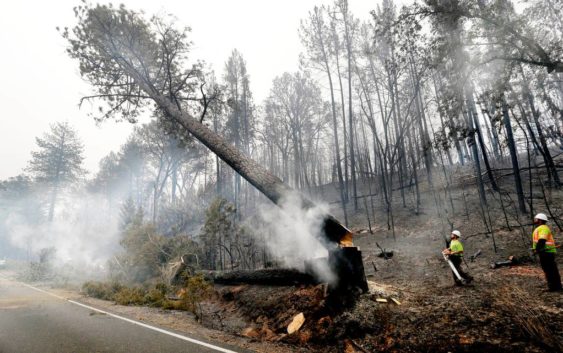- Mosquito activity on the rise due to rainfall, flooding across Texas
- Volunteers help Conroe community clean up in wake of flooding in Montgomery County
- Why leaders are urging NC residents to start hurricane prep now
- Storms could produce hail, damaging winds south of Charlotte
- Large hail and strong winds cause damage in San Marcos and the Hill Country
These forests in the West might start vanishing entirely after wildfires, study says

Wildfires tear through forests in the Western United States each year — but it’s getting harder for trees to grow back in some areas, and certain forests could disappear entirely, a new study finds.
In low-elevation wooded areas across the West in North America, climate change has created drier and warmer conditions, which make it much harder (and maybe impossible) for native ponderosa pine and Douglas fir trees to regrow after fires kill off adult trees, University of Montana researchers said in a news release on the findings. The study described the two tree species as “ecologically and economically important” in the regions where they’re found.
“The ability of forests to recover following wildfire depends on annual climate conditions, because tree seedlings are particularly vulnerable to hot and dry weather,” Kimberley Davis, a study author and postdoctoral researcher at the university, said in a statement.
The study was published Monday in the Proceedings of the National Academy of Sciences.
Sign Up and Save
Get six months of free digital access to The News & Observer
#ReadLocal
Researchers said they came to their conclusions after looking at rings from more than 2,800 trees that grew back following 33 fires from 1988 to 2015 in forests across the West, including in Arizona, California, Colorado, Idaho, Montana and New Mexico.
“We wanted to identify the specific conditions necessary for post-fire tree regeneration to better understand how climate change has been affecting forests through time,” Davis said.
This is what researchers found: Tree regrowth rates were stunted when seasonal climates — including soil dryness, humidity and temperatures — “crossed specific threshold values.” Thanks in part to climate change, conditions have hit those thresholds most years in the last two decades in forests researchers studied, meaning the number of years conditions are ripe for forests to grow back after fires has fallen precipitously, according to the news release.
That signals that some forests may not be forests for long, as “future fires in similar sites may catalyze transitions from forest to non-forest ecosystems,” researchers said.
Old trees are safer from the impacts of climate change, researchers said — assuming they don’t burn down.
“Adult trees can survive in warmer and drier conditions than seedlings,” Davis said, but she added that in those areas a future “high-severity fire may lead to ecosystem transitions from forests to grasslands or shrublands” nonetheless.
Researchers said it wasn’t a surprise to see results showing climate change is already hindering forest regrowth.
“What’s striking is if you asked scientists two decades ago how climate warming would play out, this is what they expected we’d see,” said fire paleoecologist Philip Higuera, who also worked on the study, according to the Missoulian. “And now we’re starting to see those predictions on the impact to ecosystems play out.”
Davis said the two tree species at risk are also important for the West’s forestry industry, and for their role storing carbon, promoting biodiversity and creating outdoor recreation opportunities.
It’s not the only climate change impact researchers have already documented in Western forests.
A study published in the same journal earlier this month found that wet winters in California — which were once a predictor of less damaging fire seasons — are no longer linked to less severe wildfires. The study found that, in addition to climate change, fire control practices were to blame for the fact that rainy winters can no longer ward off severe fire seasons.
“It’s not either climate change or historical fire management — it’s really a combination of the two that’s creating a perfect storm for catastrophic fires in California,” Valerie Trouet, a University of Arizona professor and author of the earlier study, said in a statement.